Carving Wildlife: Techniques Inspired by Nature's Creatures

Understanding Wildlife Carving: A Brief Overview
Wildlife carving is an art form that brings the beauty of nature into tangible creations. Artists often draw inspiration from animals, capturing their essence and characteristics through various mediums. This craft not only showcases artistic skills but also deepens our appreciation for the natural world.
Art is the most beautiful of all lies.
The practice of carving wildlife can be traced back centuries, with artisans seeking to immortalize the creatures they admire. From intricate details to lifelike representations, each carved piece tells a story. Whether it’s a majestic eagle or a playful otter, each animal serves as a muse for the artist.
In today’s world, wildlife carving has evolved, blending traditional techniques with modern tools. As more artists explore this craft, they often incorporate eco-friendly materials, ensuring that their passion for art aligns with their love for nature.
Essential Tools for Wildlife Carving: What You Need
Before diving into wildlife carving, it’s crucial to gather the right tools. Essential items include a variety of knives, chisels, and gouges, each serving a specific purpose in shaping the wood. A good carving knife, for instance, allows for precision and control, enabling artists to create fine details.

In addition to knives, sandpaper and finishing oils are vital for achieving a smooth, polished look. Sandpaper helps refine the surface, while oils can enhance the natural grain of the wood, bringing the piece to life. Investing in quality tools can make a significant difference in the carving process.
Wildlife Carving: An Artistic Journey
Wildlife carving beautifully captures the essence of animals, merging artistic skill with a deep appreciation for nature.
Don’t forget about safety gear! Protective gloves and eyewear are important to keep you safe while carving. As you become more comfortable with your tools, you’ll find that a well-equipped workspace can enhance both your efficiency and creativity.
Choosing the Right Wood for Your Carvings
The choice of wood plays a crucial role in wildlife carving, as different types offer unique qualities. Softwoods like pine are excellent for beginners due to their ease of carving, while hardwoods like mahogany or walnut provide durability and a beautiful finish. Selecting the right wood enhances the overall aesthetic of your piece.
The best artist has no conception that a marble block does not contain within itself.
It's also worth considering the texture and grain of the wood. For instance, a wood with an interesting grain pattern can add depth and character to your carvings. Some artists even choose to work with reclaimed wood, giving new life to materials that might otherwise go to waste.
Ultimately, the right wood will not only enhance your carving experience but also contribute to the longevity and beauty of your finished piece. Experimenting with various types of wood can lead to exciting discoveries in your artistic journey.
Techniques for Capturing Animal Features in Carvings
When carving wildlife, capturing the unique features of each animal is essential. Start by studying your subject closely, noting its shapes, proportions, and textures. This observation will guide you in recreating those characteristics in your carving, ensuring a lifelike representation.
One effective technique is to break down the animal’s form into basic shapes before adding details. For example, visualize a bear as a series of rounded shapes, gradually refining them to achieve realism. This approach simplifies the process, allowing artists to focus on accuracy without feeling overwhelmed.
Essential Tools for Carving Success
Having the right tools, including knives and safety gear, is crucial for successful and safe wildlife carving.
Additionally, incorporating texture can enhance the realism of your carving. Techniques such as stippling or using tools to create fur patterns can add depth and interest. Remember, patience is key—taking the time to refine details will elevate your work from good to extraordinary.
Incorporating Color into Your Wildlife Carvings
While many wildlife carvings are left in their natural wood tones, adding color can breathe new life into your creations. Water-based paints and stains are popular choices, allowing artists to enhance or alter the natural hues of the wood. Consider how color can convey the spirit of the animal you’re depicting.
When choosing colors, think about the animal's natural habitat and characteristics. For instance, a vibrant parrot may require a palette of bright greens and reds, while a more subdued deer might benefit from earthy browns and tans. This attention to detail can elevate the authenticity of your work.
Experimenting with layering techniques can also produce stunning effects. By applying multiple coats of color and blending them, you can create depth and dimension. Just remember, less is often more—start with subtle applications and build up as needed.
Finishing Touches: Preserving Your Wildlife Carvings
Once your carving is complete, applying a finish is essential for preservation. Finishing oils or waxes not only protect your work from damage but also enhance the wood's natural beauty. A well-chosen finish can accentuate grain patterns, making your carving stand out even more.
Before applying any finish, ensure your carving is clean and free of dust. This step is crucial for achieving a smooth, even application. You might also consider a test piece to determine how the finish interacts with your chosen wood.
Choosing Wood Enhances Your Art
The type of wood selected significantly impacts the quality and aesthetic of wildlife carvings, making thoughtful choices essential.
Finally, remember that the environment where your carving will be displayed matters. Keeping it away from direct sunlight or excessive moisture can prolong its life. With proper care, your wildlife carvings can be cherished for years to come.
Finding Inspiration in Nature: Where to Look
Nature is rich with inspiration for wildlife carving. Observing animals in their natural habitats can spark creativity and provide insights into their behaviors and characteristics. Whether it’s watching birds at a feeder or hiking through a forest, these experiences can enrich your understanding of the subjects you wish to carve.
Books, documentaries, and photography can also serve as excellent resources. They allow you to explore different species and their environments, broadening your artistic perspective. Many artists even keep visual journals filled with sketches and notes from their observations.

Lastly, connecting with other artists in wildlife carving communities can provide valuable insights and inspiration. Sharing experiences and techniques can ignite new ideas, helping you to grow and evolve as an artist. Remember, the more you explore, the more inspiration you’ll find!